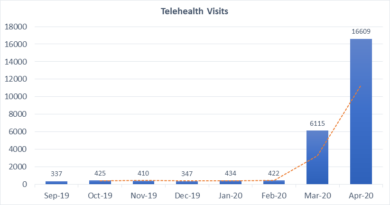IT Leadership amidst a Crisis – Lessons from the Pandemic
By Richard Lang, Ed.D CIO, Doylestown Health
Managing IT amidst a pandemic does not come without challenges to say the least. Leadership and management theories require thoughtful planning. But, in a crisis, planning and protocol go out the window! So what does a CIO do when the need to roll out IT solutions at light speed goes against every principle you have been driving home for years? Adapt, communicate, and motivate.
Introduction – What We Faced
Day one: COVID morning meeting:
Come up with IT solutions for: 1- Mobile hospital drive through testing center, 2 – MASH COVID treatment facility, 3 – Patient family communication, 4 – Transfer 150 Associates to work-at-home, 5-Deploy telemedicine solution for physician practices, 6 – tele-consult technology for inpatient virtual patient visits, and 7 – Data analytics dashboards for COVID daily stats… and the list goes on.
Day one: Afternoon IT team feedback:
“Boss, you’ve got to be kidding… that’s a pretty tall order!!!”
Spoiler: It all got done and with amazing speed, agility, accuracy, and effectiveness. Once the team got used to the fact that our usual planning cycle just crashed, we accomplished every task with great aplomb.
The Pandemic brought an unprecedented demand for our services overnight. Motivation is key to keeping your IT force driving home solutions during a crisis.
How We Adapted
When looking to adapt, turn to your nursing, and ex-military IT personnel. They are instrumental in getting past: “Hey, did our CIO just go haywire?” banter to: “OK, we need to pull this together now … here’s how we’re going to do it…” They also quickly get used to the fact that directives are less of a discussion (in a crisis) and more of a tacit “do now.” The chain of command is imperative in this situation when the “do now” versus “plan to have ready” initiatives all blur together.
Make sure you confer with your CIO colleagues as much as possible. Ask them what they are doing every day? How are they managing? What new technologies did they deploy, and what partners helped them the most. Review what you glean every day and assess how you can interject these ideas to solve problems. Float concepts that you discovered and let your team run with them, redesign them, and make them fit your organization. Moreover, make sure you fish for ideas from everyone. Leaders must draw on every creative thinker on the team. With no planning cycle, unprecedented demand for services, and constrained resources, CIOs face a daunting challenge brought on by the pandemic: Solving complex problems quickly, pragmatically, and effectively. Consequently, we let every trial balloon fly. We are always open to new concepts but even more so at the core of this battle. All thoughts and ideas have credence during an emergency. I can assure you that every member of your team wants to do a great job and even more so in a crisis. They also want to put their own stamp on it and make it fit for the organization they know and love.
“If you think you are too small to make a difference, you have never been in bed with a mosquito.1”
Communication is Key
It is impossible to over-communicate in this situation. Our CTO started a daily Zoom conference call that was attended by everyone in the department – religiously. This kind of communication is critical to update the team on all that is going on in IT, in the hospital and health system. Reporting critical stats on the hospital, community, region, and the national situation helps illuminate the current state and what might be coming our way. This daily debriefing was the key to success — especially in the early stages. It also served as an inherent motivating force – helping the team take ownership for their contribution and feel more in control of their world. When the team develops an active ownership role, they look past the problem for the answer. Consequently, IT leaders must communicate continuously and define and then redefine how actions will align with the desired outcome – safer patient care.
Motivation Doesn’t Cost a Thing
Moral of the story: Collaboration occurs naturally when all stakeholders share a common objective. In this situation, there was/is a clear objective: Do everything possible to help frontline caregivers safely and efficiently care for our community. The Pandemic brought an unprecedented demand for our services overnight. Motivation is key to keeping your IT force driving home solutions during a crisis. Pizza donations to the team get old, but the gesture is always welcomed. Many thanks to all of our partners who made sure we were all well fed during these trying days. Sharing real stories is better than anything you can buy to help your team see the result of their hard work. For example, a family was not able to visit their loved one in the last stages of life. However, they were thankful they could say goodbye with the televisit capability provided by the IT team. Stories describe how meaningful and important our work is and answer inevitable doubts of “Am I making a difference?…”
What I “Re-Learned”
I inherently knew all of this, but dealing with this Pandemic strongly reinforced how many natural and insightful leaders already existed in my sphere of responsibility. No ONE person can provide all of the leadership necessary during a major crisis. Additionally, this one is very different. With social distancing, we needed to find other ways to be present, visible, and accessible to our teams. Therefore, we also needed to delegate traditional leadership acts throughout the entire chain-of-command. Good leaders know how to do this and aren’t threatened by empowering team members to make tactical decisions on the frontline. You need to do everything in your power to encourage and inspire people, at every level; to act as if leadership is everyone’s responsibility – because it is! Some say politicians never waste the opportunity in a crisis to shape and implement policy. CIOs should also take these opportunities to develop new leaders in their organizations. Never let a crisis encumber your ability to LEAD.




Pingback: What IT Leaders Say About Employee Management During A Pandemic